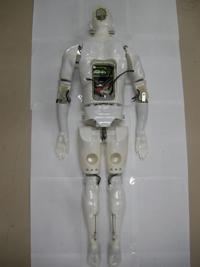Video: Swimming Robot Mimics Humans
June 27, 2012

While some humanoid robots we've reported on recently can walk up stairs or fight fires, researchers at the Tokyo Institute of Technology have developed a "swumanoid" robot they say faithfully mimics human swimming motions for applications that may include more streamlined swimsuits or methods for improving the performance of competitive swimmers. Other uses that come to mind include robots as an aid in physical therapy.
The half-scale swumanoid incorporates 20 waterproof motors that are controlled by a computer to mimic the actions of human swimmers. Tokyo Tech researchers Chung Changhyun and Motomu Nakashima say they developed the robot by carefully analyzing real human swimmers' body movements.
Previous research relied on analyzing video images of human swimmers to monitor their movements, but the researchers say this led to the problem of how to reproduce those movements. That's because this approach depends on the ability of the swimmers to recreate their own movements precisely. It also depends on the ability of researchers to make accurate measurements of the forces that are acting on swimmers' bodies while they are in motion. Both of these tasks have proven extremely difficult to accomplish.

Nakashima and his colleagues at Tokyo Tech previously developed the SWUM (SWimming hUman Model) swimming human simulation model for analyzing the whole-body dynamics of swimmers. Data for body geometry, joint motion, and specific analysis settings are given. The model estimates the fluid force acting on the swimmer's body, solves the equations of motion of the rigid human body, and computes the absolute motion of the whole human body. The developers have created a free implementation of the model called "Swumsuit" that can be downloaded here.
Two of the major issues to resolve have been reducing body resistance to movement through water and increasing the driving force caused by the swimmers' hands and feet. The swumanoid robot enables control of the precise movements and driving forces of the robot swimmer. The robot is half the size of an adult human, but has the same proportions and external features. Twelve of the 20 motors actuate the movements of the arms and one motor turns the waist. Each arm has six degrees of freedom, while the shoulder has four degrees and the elbow has two. Extra joints have been added to the shoulder to reproduce the retraction of the shoulder blade.
The swumanoid demonstrated the accuracy of both hardware and software models by its performance in reproducing the arm motions of the front crawl, which is the most complicated swimming stroke.
Changhyun and Nakashima say that in the future, they want to produce much faster swumanoids and also analyze those robots' movements to develop high-speed swimwear.
Related posts:
About the Author(s)
You May Also Like



